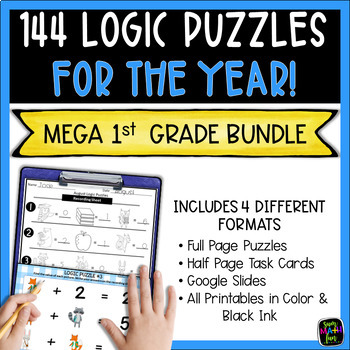Early Finishers Monthly Logic Puzzles - First Grade Mega Bundle | Fast Finisher
- Zip
What educators are saying
Products in this Bundle (12)
showing 1-5 of 12 products
Description
Grab this mega monthly bundle! ⭐A Value of $54 NOW ONLY $27.00!⭐
Do you need early finisher math enrichment for your first grade students? How about for those who already know their facts? Would you love to have a resource that deepened understanding of arithmetical strategies and mental math skills?
Try this mega bundle of 144 logic puzzles for early finishers! They are tons of fun and will keep your students learning and applying what they know.
Often when I buy resources labeled 1st-2nd grades, I find that many of the pages are too difficult for my first graders, especially in the beginning. And, there is not enough focus on the building of first grade skills before hopping into 2nd grade skills for my early finishers.
Because of the way in which math builds incrementally, math pages that work for 2nd grade don't work for 1st grade, and vice-versa. So, for these early finisher logic puzzles, I created separate resources for each grade level. You should be able to use every single page!
Each monthly set targets first grade computation skills that are specific to the time of year. The computation is kept simple so that early finishers can focus on problem solving and thinking. The beginning months target adding and subtracting within 10 to 18. See below. The targeted strategies are adding and subtracting using 0 as well as using doubles to find the picture number values.
Once you do a quick guided practice, your early finishers will be able to complete the puzzles independently in centers, as homework, or as an independent assignment. These fun puzzles are perfect for differentiated practice to extend students’ thinking.
▶️What’s Included in these Early Finisher Activities - 12 printable full-page logic puzzles in color, 12 full pages in black and white, 12 printable half-page logic puzzles in color, 12 half-pages in black & white, Google Slides of each logic puzzle for interactive computer centers, recording sheets, and answer keys!
Sets Currently Included:
- August - Back to School - Addition through 9
- September - Fall - Subtraction through 10
- October - Halloween - Addition & Subtraction through 10
- November - Thanksgiving - Addition & Subtraction through 18
- December - Christmas - Adding 3 Addends - Focus on Make 10
- January - Winter - Adding 10 more
- February - Valentine's Day - 3 Addends, Adding and Subtracting 10
- March - Saint Patrick's Day - 3 Addends, Adding and Subtracting Multiples of 10
- April - Earth Day - The unknown 1 of 4 terms in equation
- May - Bugs - Doubles and Multiples of 10
- June - At the Beach - Mixed Review
- July - Summer Frogs - Mixed Review
I think you'll really LOVE these early finisher activities!
✋ Looking for more engaging activities? Check out these popular resources!
✅ Early Finishers and Gifted: Math Challenges: Teacher Life-Saver!
✅ Measurement Activities for First Grade - Nonstandard
✅ Addition Facts and Subtraction Facts Math Centers and Games Super Hero Theme
✅ Addition and Subtraction Worksheets - Color by Number Year Long Bundle
Have fun Mathing!
-Leah





